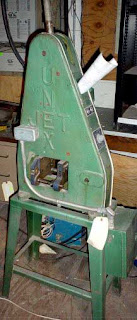I remember his early experiments with plastic. Plastic material in the form of granules was poured into a machine that heated the material until it melted and became soft enough to be injected under pressure to fill a mold. This process could create many exact copies from one mold. While he was learning the process, he used pre-made molds for small toys, such as cowboys or animals, and shared the results with us, his young daughters. We enjoyed this influx of colorful plastic toys, and were not bothered by imperfections of some of his early trial runs.
These memories came flooding back when an unexpected email arrived in February 2017. A correspondence ensued, photos were shared, and I learned more about the plastic molding machine that my father developed. He not only used it in his factory, but also began selling the machine itself as a product called the UNEX JET. The photo at right was sent to me by Jeff Saxton of St. Louis, MO, who still actively molds plastic parts with it!
Jeff's email inspired me to write the following piece for the Danvers Herald.
UNEX Jet: Daddy’s plastic molding machine
by Sandy Nichols Ward
During my childhood, my father designed and redesigned hearing aids, gradually making the units smaller and lighter. The old metal cases, recycled from boxes in which nails were once sold, gave way to plastic cases for the newer models. Daddy was an electrical engineer, not an expert in plastics. For a while he had to rely on other companies to produce and supply the plastic parts needed for the assembly of his UNEX hearing aids. At some point he decided to learn how to make plastic parts himself.
Daddy’s early experiments with plastic were fun for us as children. The first molding machine he acquired came with molds for shaping small plastic toys. As he learned to operate it, he made soldiers, cowboys, Indians, and other figures in bright colors. The pieces were not always perfectly formed, but we weren’t fussy. We enjoyed the output of his molding experiments.
It was like getting prizes in the bottom of our breakfast cereal boxes, but these came freely, without having to eat the cereal. I recall some talk about whether Daddy might begin selling plastic toys to cereal companies, but I don’t think he was serious. He also laughed off a crazy proposal that came his way about making an electric toothbrush. He exclaimed, “Who ever heard of such a thing?” (Years later he admitted that he’d missed an opportunity on that one.)
Daddy did proceed to make plastic parts, and in fact he designed a much better molding machine. He named it the UNEX Jet. With that injection molding machine he not only could make parts his company needed, but could make parts to sell to others. His factory, UNEX Laboratories on U.S. Route 1 in Danvers, advertised
“Fast Service – Low Cost
PLASTIC MOLDS & PARTS
For prototypes, short or production runs
of small injection molded plastic parts.”
Last week I was surprised to receive an email from someone who owns one. Jeff Saxton, of St. Louis, MO, wrote, “Hello, I own a Unex Jet benchtop injection molder, and wondered if you had any further information on the Nichols & Clark firm as it relates to these small molders?” I provided some information, and he shared a photo of his machine, which I recognized instantly. He bought it, used, in 1995 to make plastic parts for model train kits. With it, he has made thousands of parts (in eight different dies that he machined expressly for this machine). “It still works great, and that's a testament to your father's design.”
Jeff added some history that I had not known. These machines were sold by Hinchman Manufacturing (Roselle, New Jersey) in the 1960’s, and later by Kissam Manufacturing (Mountainside, New Jersey), a company founded in 1976. Trade schools and small machine shops were the major buyers. Jeff’s machine wears a Kissam label. On the Internet we found a photo and description from Hinchman. To my eyes, the UNEX Jet looks identical, whether sold by Nichols & Clark (UNEX Laboratories), Hinchman, or Kissam.
I’m glad to know that some of them are still around and being useful. My father, Nathan P. Nichols (1912-1996), would have been pleased. I certainly enjoyed being reminded of his role in plastics, and the toys that came from his early tests.
______________________________
Below are additional images sent to me by Jeff Saxton, who has been researching the history of the Unex Jet, and trying to trace the source of his machine.
 |
| Unex Jet Benchtop Molding Machine (#I2033) Manufactured 1969 Specifications: Model 128MM 750 degrees 115/1/60 600 watt heater 5.2 AMPS (from ad at jstrading.bizland.com/I2033.htm) |
Jeff also wrote on 3/7/17, "Another small piece of the puzzle I have found. It's a PDF of a trade publication from 1966 -- the ad in the lower right of page three for Cope Plastics..." That ad, in the January 1966 issue of American Vocational Journal, lists "UNEX JET Injection Molding Machine" at the end of a long list of items under the heading "COPE PLASTICS for ALL Your Needs in Plastic Craft Supplies." Jeff commented, "I've been to the Cope location hundreds of times after they moved into St. Louis proper from their original Godfrey, Illinois, location. So Cope was active in promoting the use of Unex Jet machines locally to trade schools or Industrial Arts programs. I would even bet my machine was bought via them by whoever the original owner was."






2 comments:
I just bought one of these machines. Does anybody have a manual?
I do not have a manual for the UNEX Jet, nor know if my father ever created one. Sorry.
Jeff Saxton, who has decades of experience using a UNEX Jet, reports that a firm he once worked for acquired a UNEX machine circa 1987 or 1988. Jeff says it came with a booklet, which has since been lost. Jeff wrote, "As I recall, it was a very general document more along the lines of 'congrats, you bought our machine', with little real detail on specs or operations." "... just a quick primer on the initial set-up and use." Jeff has not yet found a real manual.
I could put you in touch with Jeff Saxton, if you wish. He's willing to answer questions. Please send me email (privately) via the form linked under my photo in the "About Me" section, in left sidebar of this blog. I could then forward your email to Jeff, so he could correspond with you. He'll probably be quite interested to learn about your machine. He maintains a list of different companies that have sold the UNEX Jet machine over the years.
Post a Comment